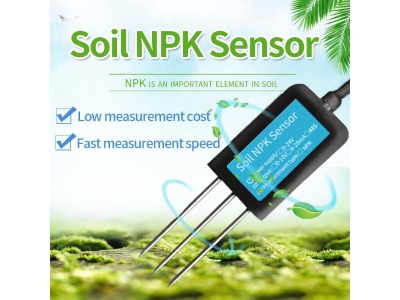Agriculture is one of the oldest and most critical industries in the world. It provides food, fiber, and fuel for billions of people worldwide, sustaining life and driving economic growth. However, the industry faces significant challenges related to population growth, climate change, resource scarcity, and environmental degradation. To overcome these challenges, agriculture must embrace innovation and adopt more sustainable and efficient farming practices. One such innovation that holds great promise is soil sensor technology.

Soil sensors are devices designed to measure various soil properties and parameters, providing real-time data on soil moisture, temperature, nutrient levels, and other critical parameters. By collecting this data, soil sensors enable farmers to make informed decisions, optimize resource usage, enhance crop yields, and minimize environmental impact. This technology has numerous benefits for agriculture, which we will explore in this article.
Improved Irrigation Management
Irrigation is crucial for crop growth, but inefficient irrigation practices can lead to water waste and reduced crop yields. With soil sensors, farmers can receive real-time data on soil moisture content, enabling them to make more accurate decisions about when and how much water to apply to their crops. This technology eliminates guesswork and minimizes the risk of under-irrigation and over-irrigation, preserving water resources and maximizing crop yields.
Precision Nutrient Management
Nutrient management is essential for crop growth, but excess fertilizer can harm the environment and lead to groundwater contamination. Soil sensors provide farmers with real-time information on soil nutrient levels, allowing for targeted application of fertilizers. Farmers can monitor nitrogen, phosphorus, potassium, and other essential nutrients, adjusting fertilizer applications accordingly. This precision nutrient management maximizes crop yields while minimizing nutrient runoff and environmental pollution.
Enhanced Crop Planning and Yield Optimization
Soil sensors enable farmers to understand soil conditions such as pH levels, salinity, and organic matter content, allowing them to choose crops that are best suited to particular soil conditions. Additionally, soil sensors enable early detection of soil health issues or imbalances, allowing farmers to take corrective measures before they adversely affect crop growth. With this knowledge, farmers can optimize their planting decisions, improve crop yields, and reduce potential losses.
Reduced Environmental Impact
Soil sensors minimize wastage of resources such as water and fertilizers, enabling more efficient use and reducing environmental impact. By providing real-time data on soil moisture and nutrient levels, farmers can precisely apply water and fertilizers, minimizing wastage. This targeted approach not only reduces costs but also mitigates the risk of nutrient leaching and groundwater contamination. By implementing precision irrigation and nutrient management strategies guided by soil sensor data, farmers contribute to sustainable farming practices and promote environmental stewardship.
Integration with Smart Farming Systems
Soil sensor technology seamlessly integrates with other smart farming systems, such as remote sensing, drones, and automated machinery. By combining soil sensor data with satellite imagery and weather forecasts, farmers can gain a comprehensive understanding of their fields’ conditions. This integration enables them to make data-driven decisions related to irrigation, fertilization, pest control, and harvesting timelines. Moreover, automated machinery and irrigation systems can be linked to soil sensor data, allowing for precise execution of farming operations, reducing labor requirements, and improving overall efficiency.

Farmers’ Empowerment and Knowledge Sharing
As soil sensor technology becomes more accessible and affordable, it empowers farmers with valuable information and knowledge about their fields. By deploying soil sensors, farmers gain insights into their soils’ characteristics, enabling them to make informed decisions and fine-tune their farming practices. Furthermore, the data collected from soil sensors can be shared with agricultural extension services and research institutions, fostering knowledge sharing and collaborative efforts to improve farming techniques. This collective knowledge benefits the entire farming community and drives innovation in agriculture.
Challenges and Future Outlook
While soil sensor technology has immense potential, it also faces certain challenges. Calibration and maintenance of sensors, data interpretation, and integration with existing farm management systems require technical expertise and support. Additionally, ensuring widespread adoption and affordability of soil sensors among small-scale farmers remains a challenge. However, advancements in sensor technology, improved data analysis algorithms, and i
